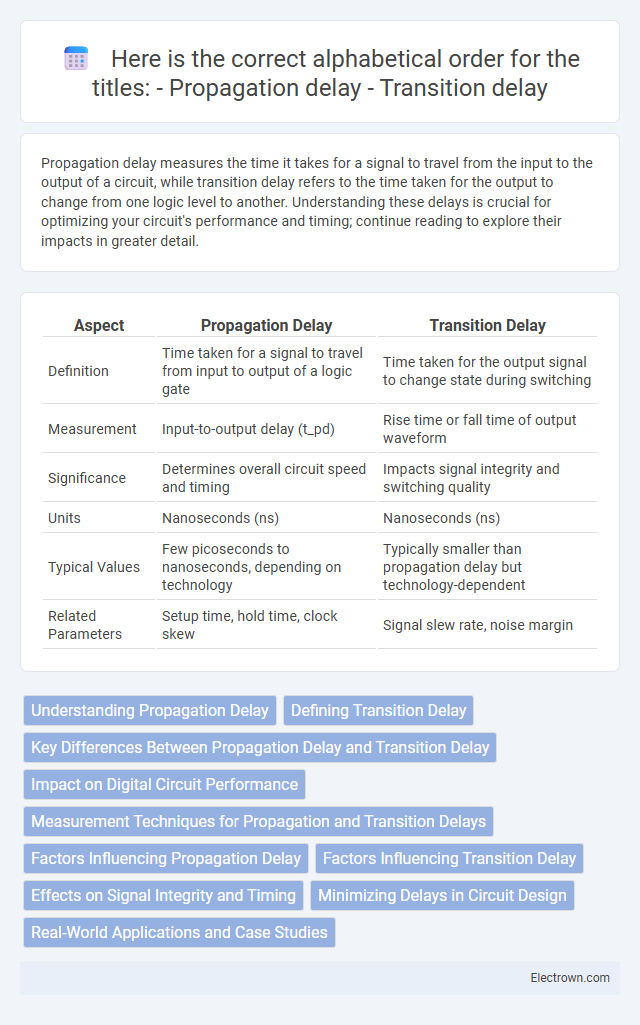Propagation delay measures the time it takes for a signal to travel from the input to the output of a circuit, while transition delay refers to the time taken for the output to change from one logic level to another. Understanding these delays is crucial for optimizing your circuit's performance and timing; continue reading to explore their impacts in greater detail.
Table of Comparison
| Aspect | Propagation Delay | Transition Delay |
|---|---|---|
| Definition | Time taken for a signal to travel from input to output of a logic gate | Time taken for the output signal to change state during switching |
| Measurement | Input-to-output delay (t_pd) | Rise time or fall time of output waveform |
| Significance | Determines overall circuit speed and timing | Impacts signal integrity and switching quality |
| Units | Nanoseconds (ns) | Nanoseconds (ns) |
| Typical Values | Few picoseconds to nanoseconds, depending on technology | Typically smaller than propagation delay but technology-dependent |
| Related Parameters | Setup time, hold time, clock skew | Signal slew rate, noise margin |
Understanding Propagation Delay
Propagation delay refers to the time it takes for a signal to travel from the input to the output of a digital circuit, typically measured in nanoseconds. This delay influences the overall speed and performance of electronic systems, especially in high-frequency applications. Accurate estimation of propagation delay is critical for timing analysis and ensures reliable synchronization within digital circuits.
Defining Transition Delay
Transition delay refers to the time taken for a signal to change from one logic state to another, typically measured between 10% and 90% of the voltage swing. It directly impacts the speed at which your digital circuits respond to input changes, influencing overall performance. Unlike propagation delay, which measures the total time for a signal to travel through a component, transition delay focuses on the signal's rise or fall time during state transitions.
Key Differences Between Propagation Delay and Transition Delay
Propagation delay measures the time required for a signal to travel from the input to the output of a digital circuit, reflecting the overall response time of the system. Transition delay, on the other hand, focuses on the time taken for the output to switch between logic levels, specifically the rise or fall time of the signal. Understanding these key differences helps you optimize circuit performance by addressing both the signal travel time and output transition speed separately.
Impact on Digital Circuit Performance
Propagation delay impacts digital circuit performance by determining the time it takes for a signal to travel from the input to the output of a logic gate, directly affecting the maximum operating frequency and overall speed of the circuit. Transition delay, which measures the time required for the output signal to change states (rise or fall time), influences signal integrity and the likelihood of timing errors such as glitches or setup and hold violations. Minimizing both delays is critical for optimizing timing margins, reducing latency, and ensuring reliable high-speed operation in complex integrated circuits.
Measurement Techniques for Propagation and Transition Delays
Propagation delay and transition delay are measured using high-precision oscilloscopes or time interval analyzers that capture signal waveforms at input and output nodes. Propagation delay is typically quantified as the time interval between the 50% voltage points of the input and output signals, while transition delay is measured as the rise or fall time between 10% and 90% voltage levels on the output waveform. Accurate timing analysis techniques, such as time-to-digital converters (TDCs) or automated test equipment (ATE), help characterize delay parameters critical for optimizing your circuit performance.
Factors Influencing Propagation Delay
Propagation delay is mainly influenced by factors such as the physical length and material of the interconnect, the capacitance and resistance of the circuit elements, and the operating voltage and temperature. Transition delay depends on the transistor switching speed, the load capacitance, and the drive strength of the gate. Variations in these parameters directly affect signal timing and overall circuit performance.
Factors Influencing Transition Delay
Transition delay is primarily influenced by factors such as signal rise and fall times, load capacitance, and transistor switching characteristics, which determine how quickly an output voltage changes from one logic level to another. Variations in manufacturing processes, temperature fluctuations, and supply voltage levels also impact the speed of transistor transitions, thereby affecting transition delay. Understanding these elements helps you optimize circuit speed and improve overall timing performance beyond just propagation delay considerations.
Effects on Signal Integrity and Timing
Propagation delay impacts signal integrity by causing timing mismatches that can lead to setup and hold time violations in high-speed circuits. Transition delay affects the slope of the signal waveform, influencing noise margins and potentially causing signal distortion or crosstalk. Both delays must be minimized and carefully balanced in timing analysis to ensure reliable synchronization and prevent data corruption in digital systems.
Minimizing Delays in Circuit Design
Minimizing propagation delay and transition delay is crucial for enhancing circuit performance and ensuring timely signal processing in high-speed designs. Techniques such as optimizing transistor sizing, reducing load capacitance, and employing buffer insertion effectively decrease these delays, leading to faster signal propagation and sharper output transitions. Careful layout optimization and using advanced semiconductor technologies further contribute to reducing both propagation and transition delays, improving overall circuit efficiency and reliability.
Real-World Applications and Case Studies
Propagation delay critically impacts high-frequency communication systems by determining the maximum data transmission speed, as demonstrated in fiber optic networks where minimal delay ensures real-time data exchange. Transition delay affects digital circuits' switching speed, influencing power consumption and reliability, a factor extensively analyzed in microprocessor design case studies to optimize clock frequencies and thermal performance. Both delays are crucial in automotive radar sensors, where precise timing guarantees accurate object detection and collision avoidance in autonomous driving systems.
Propagation delay vs transition delay Infographic

 electrown.com
electrown.com